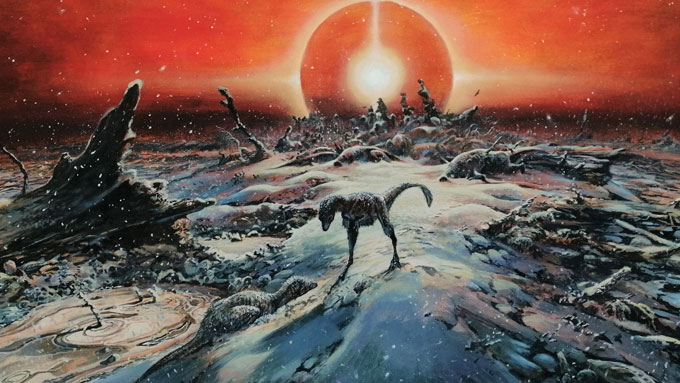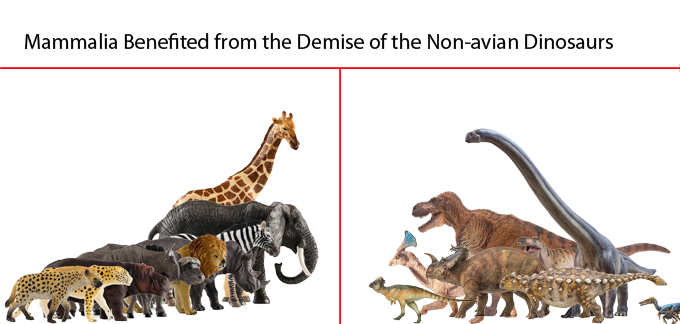Very Unlucky Dinosaurs According to New Research
The extra-terrestrial impact event that marked the end of the Mesozoic is estimated to have wiped out more than three-quarters of all the marine animal species, including most of the marine reptiles and devastated life on land resulting in the extinction of the non-avian dinosaurs and the Pterosauria. As terrible the impact was, it was made worse by the presence of vast amounts of sulphur within the rocks that bore the brunt of the impact. In the immediate aftermath the sulphur particles thrust high into the atmosphere caused acid rain, blocked sunlight and prolonged planetary-scale cooling exacerbating the extinction event.
It seems the dinosaurs were just very unlucky…

The K-Pg extinction event was exacerbated by the high levels of sulphur at the extra-terrestrial impact site that led to prolonged global cooling. Picture credit: James McKay
Picture credit: James McKay
Unlucky Dinosaurs
Scientists from the University of Bristol, St Andrews University, Syracuse University (New York), Texas A&M University (College Station, Texas) and Ellington Geological Services (Houston, Texas), have published a paper in the prestigious Proceedings of the National Academy of Sciences that explores the consequences of the extra-terrestrial impact event.
They conclude that the expulsion of huge amounts of sulphur into the atmosphere contributed directly to the extinction of the dinosaurs.
The researchers found that sulphur gases circulated globally for years in the Earth’s atmosphere, cooling the climate and contributing to the mass extinction of life. This extinction event was catastrophic for the non-avian dinosaurs and other life, but also allowed for the diversification of mammals including primates, which ultimately led to the evolution of hominins such as our own species.
A Rapid and Catastrophic Change in the Global Geological Record
Commenting on the significance of the research, co-author of the paper Dr James Witts (School of Earth Sciences, University of Bristol) stated:
“Our data provides the first direct evidence for the massive amounts of sulphur released by the Chicxulub impact. It’s amazing to be able to see such rapid and catastrophic global change in the geological record.”
Sulphate aerosols have been implicated previously in the end-Cretaceous mass extinction event which marked the demise of the non-avian dinosaurs and the start of the “Age of Mammals”. The research team were able to examine the rare sulphur isotopes in material ejected by the impact and deposited in a nearby sea, now represented by rocks found along the Brazos River in Texas.
By examining the concentration of the sulphur deposits the team could assess the devastating consequences of the release of huge quantities of sulphur into the atmosphere some 66 million years ago.
The Effect of Atmospheric Sulphur
Atmospheric sulphur in the stratosphere scattered incoming solar radiation and prolonged planetary-scale cooling for many years after the original impact, causing acid rain and reducing the light available for photosynthesis which further depleted terrestrial vegetation and marine plankton extending the time it would have taken for food chains to recover.
Corresponding author Christopher Junium (Syracuse University) added:
“The initial effects of the impact were caused by rock dust, soot and wildfires, but the sulphur aerosols extended the time period over which life would have suffered from extreme cooling, reduced sunlight and acidification of the land surface and oceans. And it was this extended duration of cooling that likely played a central role in the severity of the extinction.”
Three Hundred Billion Tonnes of Sulphur – Unlucky Dinosaurs
In 2017, Everything Dinosaur produced an article that looked at similar research published in Geophysical Research Letters that examined the impact that may have ejected 300 billion tonnes of sulphur into the planet’s atmosphere. This paper too, emphasised the devastation caused by sulphur aerosols and it examined the consequences of the event, which they estimated caused a temperature drop on land by as much as 17 degrees Celsius.
The Japan-based researchers also calculated that had the catastrophe occurred elsewhere on the planet, the dinosaurs may not have become extinct and the resulting macroevolution of the mammals may not have occurred. Lucky for us, it did, to read our 2017 article: Chicxulub Impact – A Really Bad Place to Hit.

The extinction of the non-avian dinosaurs permitted the Mammalia to diversify and become the dominate terrestrial fauna. Picture credit: Everything Dinosaur.
Picture credit: Everything Dinosaur
The dinosaur figures in the picture above come from the PNSO model range.
To view this range: PNSO Age of Dinosaurs Models.
Lucky for us, the non-avian dinosaurs were very unlucky…
Everything Dinosaur acknowledges the assistance of a media release from the University of Bristol in the compilation of this article.
The scientific paper: “Massive perturbations to atmospheric sulfur in the aftermath of the Chicxulub impact” by Christopher K. Junium, Aubrey L. Zerkle, James D. Witts, Linda C. Ivany, Thomas E. Yancey, Chengjie Liu and Mark W. Claire published in The Proceedings of the National Academy of Sciences.
The Everything Dinosaur website: Dinosaur Toys.

